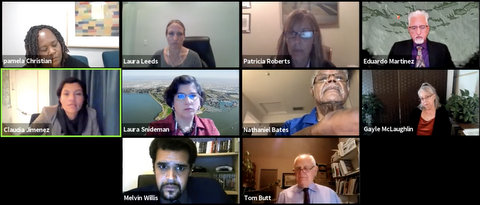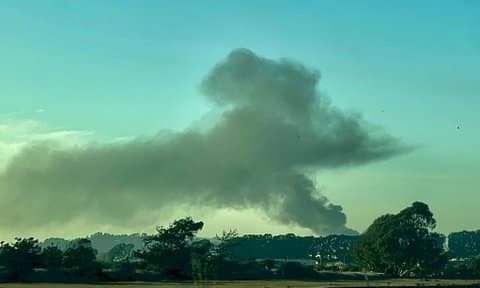
05 Nov City Council Pushes Back Against Chevron’s Report On Flaring

(Screenshot captured by Mathew Miranda / The CC Pulse)
By Mathew Miranda
Richmond council members chastised and questioned Chevron representatives Tuesday following a report on the recent string of flares at the refinery.
The round of flares sent flames, smoke and toxic fumes into the air while also being rumored to be the source of a strong gas smell that closed three schools Oct. 25. State and local agencies continue to investigate the events with no clear answer yet on the exact source of the odor. But, according to an Oct. 28 KQED article, close to 17 tons of sulfur dioxide were released over two days.
Despite these findings, Laura Leed, incoming process safety manager for the refinery, said residents should not be concerned for their health. She emphasized that testing by Chevron and outside agencies did not find violations of air quality standards near the refinery.
“Our readings were all under key detection limits and well below health standard limits in our surrounding neighborhoods… I don’t feel anyone should be concerned about their health,” Leed said.
Council member Eduardo Martinez argued this may show that the regulatory standards around Chevron are not strict enough. He also raised concerns about the cumulative effect of flares and chemicals being released in the air. Martinez recommended Chevron conduct studies on whether repeated flares can cause future harm.
>>>Read: Council Calls for Transparency on Chevron Flaring
“If I have to continue going to a room where people are smoking, eventually my body is affected by the smoke,” Martinez said.
Council members Gayle McLaughlin and Claudia Jimenez questioned why flaring from Chevron’s Richmond facility seems to be increasing. It has conducted the most flaring operations of any Bay Area refinery, according to the same Oct. 28 KQED article. Jimenez also referenced conversations with Contra Costa County Supervisor John Gioia, who has publicly expressed concerns about the increase.
“It’s not that it happens casually; it happens a lot,” Jimenez said.
Patricia Roberts, outgoing process safety manager for the refinery, recognized the council’s worries but labeled flares an “essential safety device.” The technique, often used by refineries, eases pressure and burns any excess gas buildup in pipes or equipment.
In the case of the recent flares, Roberts said multiple process units at the refinery lost power during a rainstorm. This resulted in steam production loss and the need for flaring.
“It ensures that the equipment continues to operate during safe modes of operation,” she said.
Roberts also said Chevron has invested millions of dollars in equipment to reduce flaring and lessened its flare activity since 2019 and 2020. She attributed the recent flares solely to the storm activity.
Although he acknowledged the safety component, Mayor Tom Butt cited his disappointment in the presentation. He called on Chevron to take more ownership of the flares, recognize the fear it causes and pledge to “do better.” Butt added that the general manager of the Richmond refinery should have attended Tuesday’s meeting to apologize instead of sending two representatives.
“Whether it’s dangerous to health or not, that’s another story,” Butt said. “But it scares people.”
>>>Read: “Chevron Is On Fire” Again. Change Is Long Overdue.
Dissatisfaction in Chevron’s report led to unanimous approval from the council, requesting KCRT to reproduce the segment of this discussion and forward it to the Chevron president, vice president and general manager of Richmond refinery.
Council member Melvin Willis also encouraged Chevron to return to a future meeting to address the detectable limits of air quality violations and how close flares get to reaching these violations.





No Comments